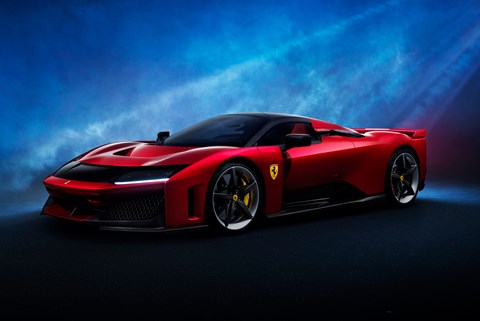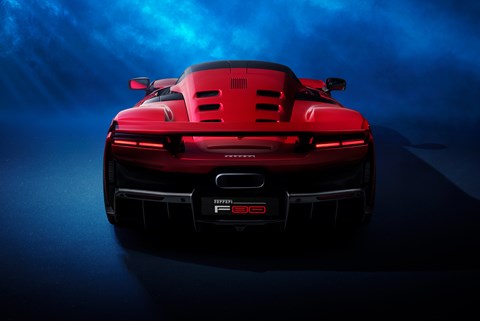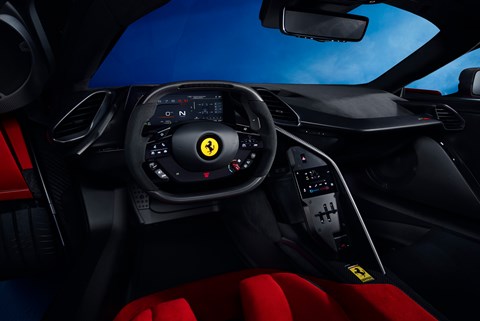► New Ferrari F80 supercar unveiled
► F1 tech for the road in Maranello’s successor to LaFerrari
► Limited to 799 units and costs from £2.6m plus VAT
288 GTO, F40, F50, Enzo, LaFerrari and now the ballistic Ferrari F80 – the latest in a long line of hallowed supercars from Ferrari is being touted as the ultimate expression of Ferrari F1 knowhow for the road.
Featuring ground effect and active aero that generates 1000kg of downforce at 155mph and a hybrid V6 turbo that has drawn inspiration from the F1 and WEC racing cars, the F80 is a limited-edition demonstration of supremacy of everything that Ferrari has learnt from its racing and road car programs.
But unlike some others that have gone before (the Aston Martin Valkyrie, for instance), Ferrari claims the F80 will be easy to drive. By deliberately setting out to engineer a car that customers will want to use all the time, the firm claims that the F80 will offer the best example of extreme performance and extreme versatility. Quite how often that proves true in reality is probably a moot point, but the £2.6m starting price (plus taxes) means it’s unlikely you’ll see one in your local Tesco car park any time soon.

Presumably it’s fast?
The stats are, predictably, on another level from anything before from Maranello. The 3.0-litre ICE engine produces 888bhp, red lines at 9200rpm and has a specific output of 296bhp per litre (incredibly high, but not quite on the Mercedes-AMG One level); twin electric motors on the front axle add another 282bhp (and make it permanent four-wheel drive); torque is 627lb ft from the V6 and 178lb ft from the front electric motors; 0-62mph takes just 2.15 seconds and 0-125mph in 5.75 seconds.
To put that latter figure in historical context, the LaFerrari was over a second slower.
But where the F80 will feel different is in its delivery – by using two fairly large capacity turbos nestled in the middle of the 120-degree V and each gaining an e-motor between the turbine and the compressor, Ferrari promises instant power delivery. It does without variable vane turbos but then they aren’t needed because the e-motors do all the torque fill. Lag shouldn’t be an issue.

There’s a further electric motor mounted under the engine, dubbed MGU-K to acknowledge the F1 link, that further boosts power and can be used for regen. Then if you also count the front twin electric motors, it brings to five the number of e-motors just powering the thing.
Start to count the motors on the fully active suspension (another four) and the rear wing and you’re into double figures.

The F1 association continues with an MGU-H that generates its power from the turbos’ waste gases and a DRS-esque reverse Gurney flap at the front that is capable of stalling the airflow entering the underbody, thereby reducing drag. At the rear, a moveable wing raises and also tilts fore and aft according to driver inputs to the throttle, brakes and steering, in order to either reduce drag or give more downforce. Balancing it all must have meant many hours in the wind tunnel – 1000kg of press needs to be carefully managed across each surface.
That’s also the reason for the fully active suspension. Similar in principle to that which operates on the Purosangue SUV, the Multimatic system can control each corner individually, a vital aspect given how much aero is at play. It also means there are no anti-roll bars.
Likewise no rear-wheel steer but with the twin electric front motors allowing for torque vectoring, Ferrari argues it isn’t needed. And it also helps save the weight of complicated rear wheel steer.
The chassis is a carbon, aluminium and titanium mix that runs to a dry weight of just 1525kg (a LaFerrari was 1485kg). Being a hybrid, weight was always at the front of Ferrari’s mind, with reduction measures such as 3D printed suspension parts, an integrated cooling system on the front inverter, while Ferrari has also revised the cylinder block, crankcase, timing cover and other components on the V6, as well as employing titanium screws. The result is an engine that weighs the same as the V6 in 296 but produces an additional 234bhp. Further impressive diets are the front axle set-up being 36kg lighter than on the SF90 and the 38kg shaved off the 2.3kWh battery compared to the one in the SF90.
It doesn’t look like your everyday supercar
Emerging onto the stage at Maranello with predictably dramatic music, the first thing that strikes you about the F80 is how compact the cabin looks. It’s accentuated by the wide shoulders and low stance (the F80 stands just 1138mm tall) and with the low slung rear deck, it screams a razor-sharp purpose that clearly follows on from the F40 and F50 forebears, albeit with modern touches; the black arc across the front is a nod to the recent 12Cilindri.

The interior layout is interesting. Ferrari debated making it a single-seater in order to deliver the ultimate driving machine with minimal compromise, but in the end settled on a ‘1+’ seating arrangement that is meant to put the driver slightly further forward. Unlike the McLaren W1, where both seats are fixed and the pedals move, the F80’s arrangement is mixed one: the driver’s seat moves fore and aft but the passenger’s is rigid.
Ferrari says this staggered arrangement means the two seats can be positioned closer together because you won’t rub shoulders with your passenger, which also benefits the exterior dimensions as the car can be narrower and therefore more aero efficient.
A lot of major controls are mounted on the steering wheel, following Ferrari’s recent trend, but in this instance they’re physical buttons and no longer haptic. Good, as the touch ones in the 296 series are virtually inoperable.
Any rivals?
Funny you should mention that. It’s going to be a bumper time in the hypercar class as the F80 has been announced barely a month after McLaren unveiled the W1. Also featuring a hybrid set-up, only this time with 1258bhp via the rear wheels only, the difference in acceleration figures shows how the alternative approaches to traction will translate on the road. The W1 is 0.55 seconds slower to 62mph but by 100mph, it’s closed the gap to 0.05 seconds.
As for the other member of the holy trinity of LaFerrari, McLaren P1 and Porsche 918 Spyder, the Porsche Mission X was announced as an all-electric alternative and with a possible launch date of 2027.
Now, in the 2020s, you can also add the Bugatti Tourbillon to the list. Previously, the Veyron and Chiron were a class above but thanks to McLaren and Ferrari raising the prices of their cars this time around, it drags in exotica like the Bugatti. Or Koenigsegg.